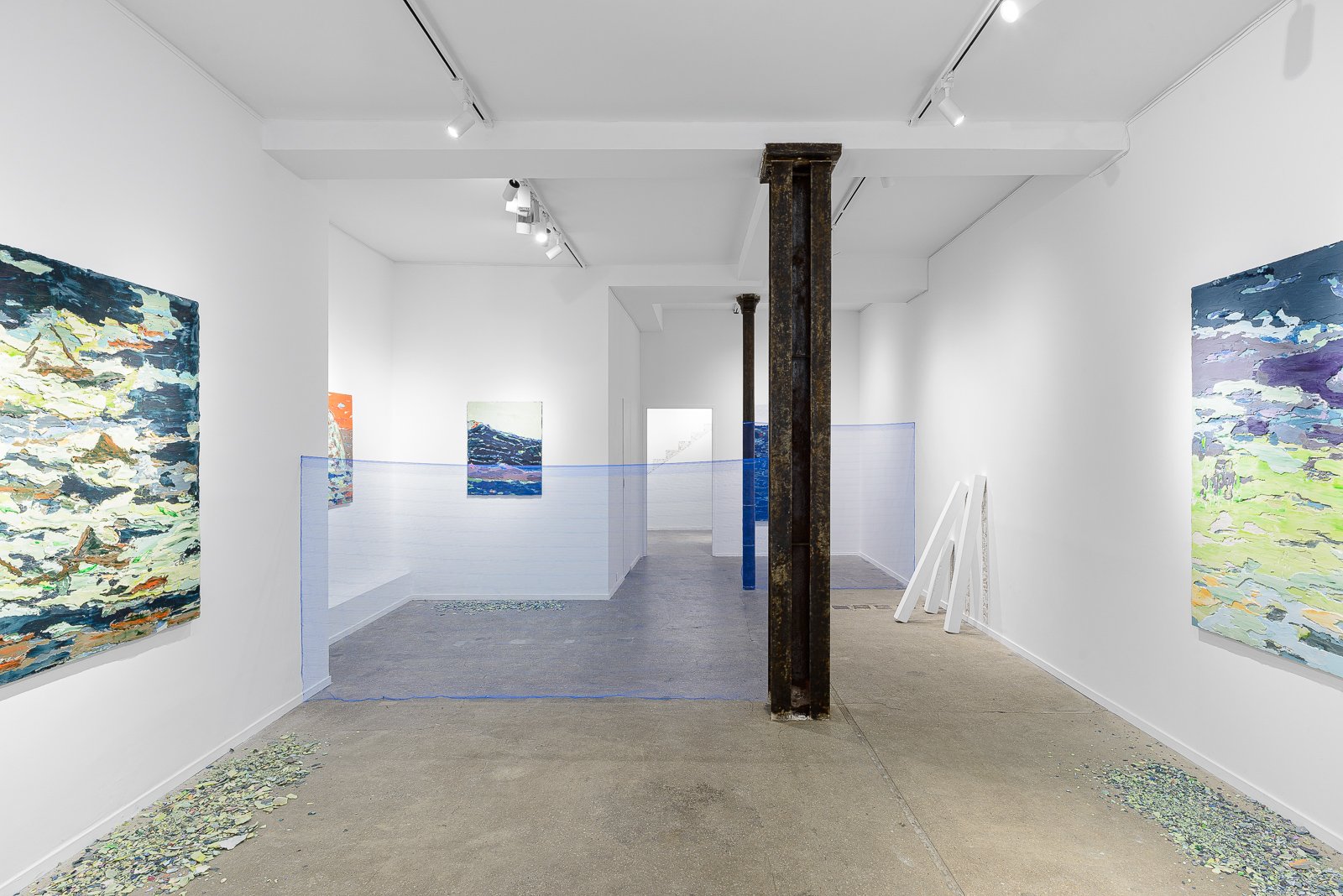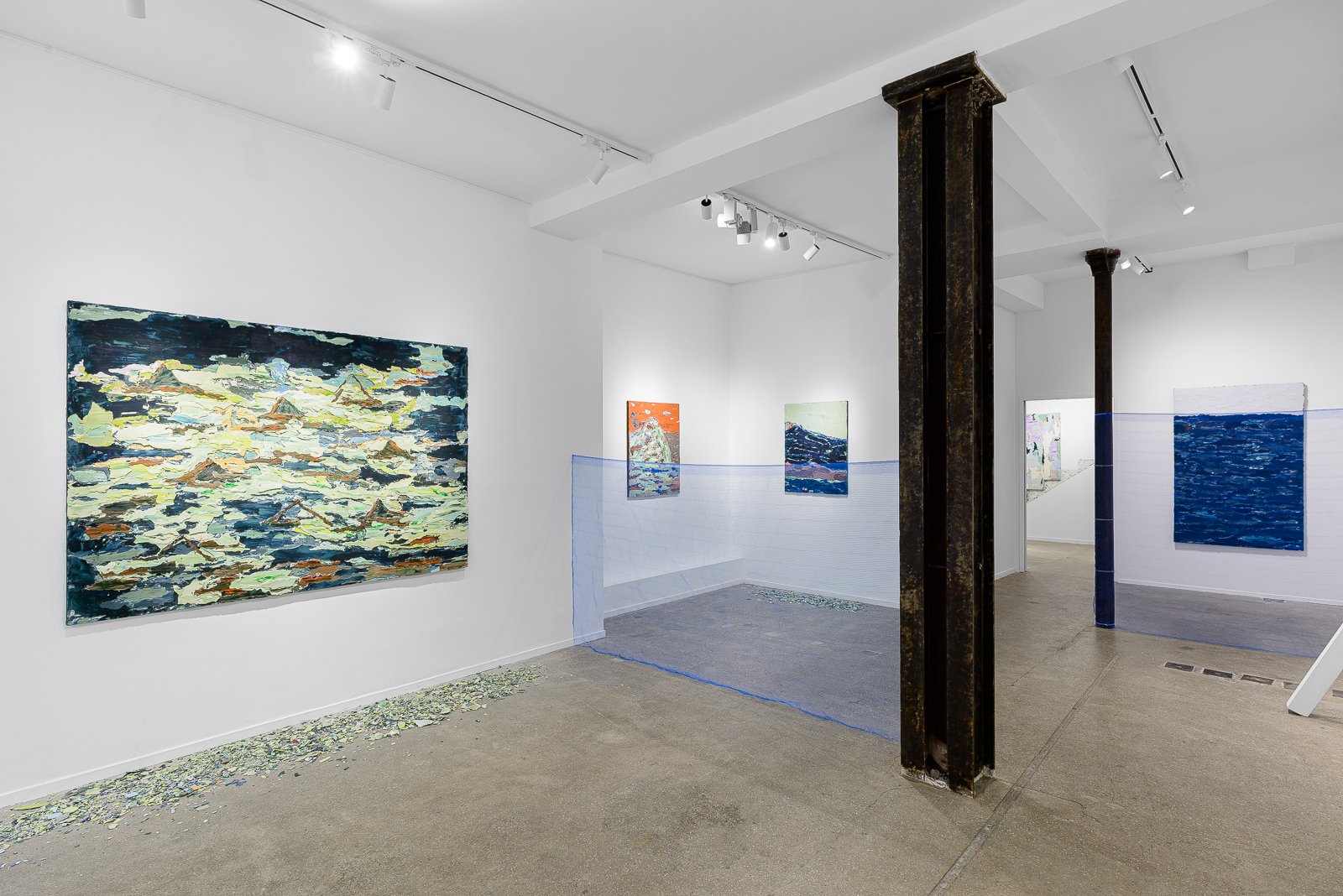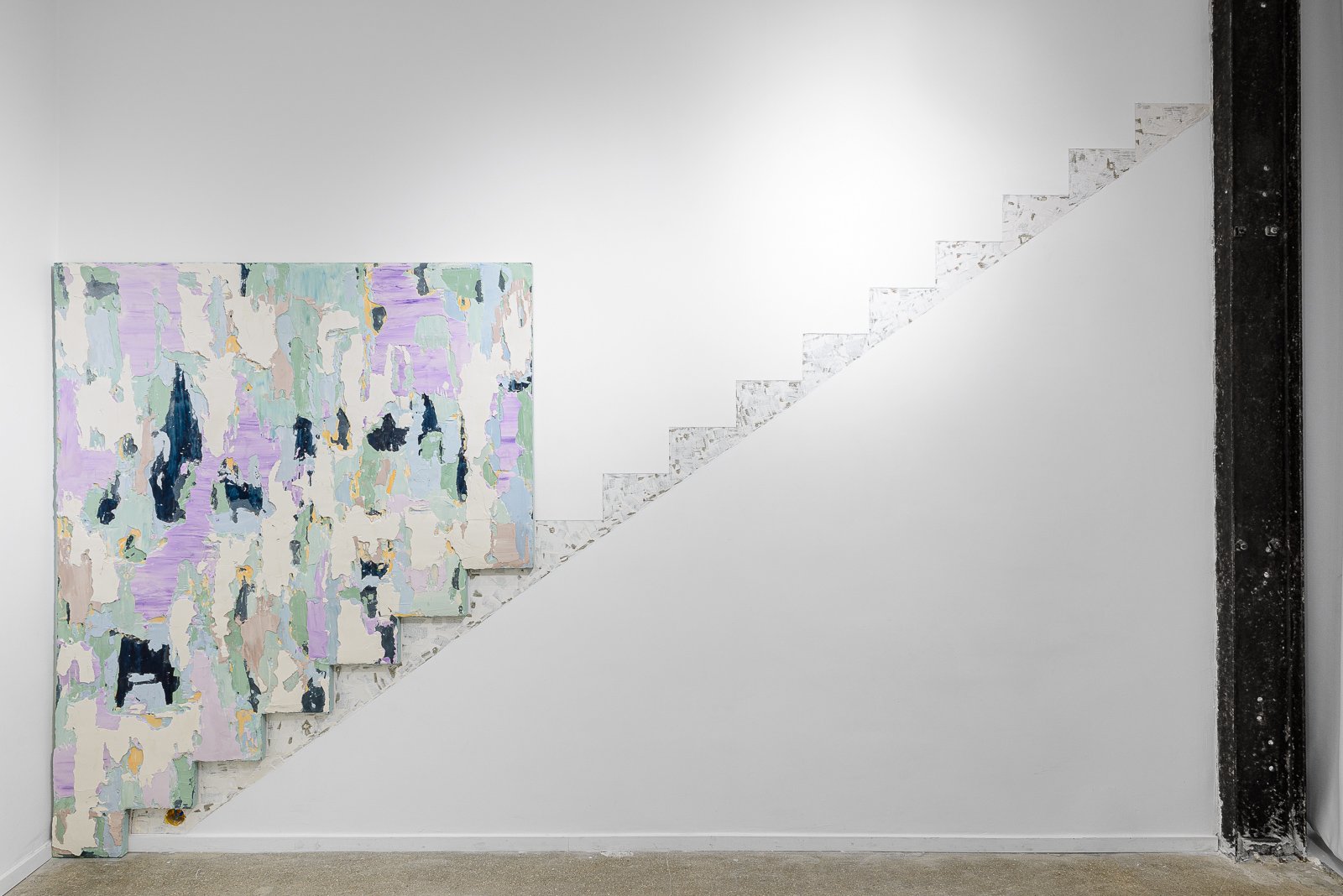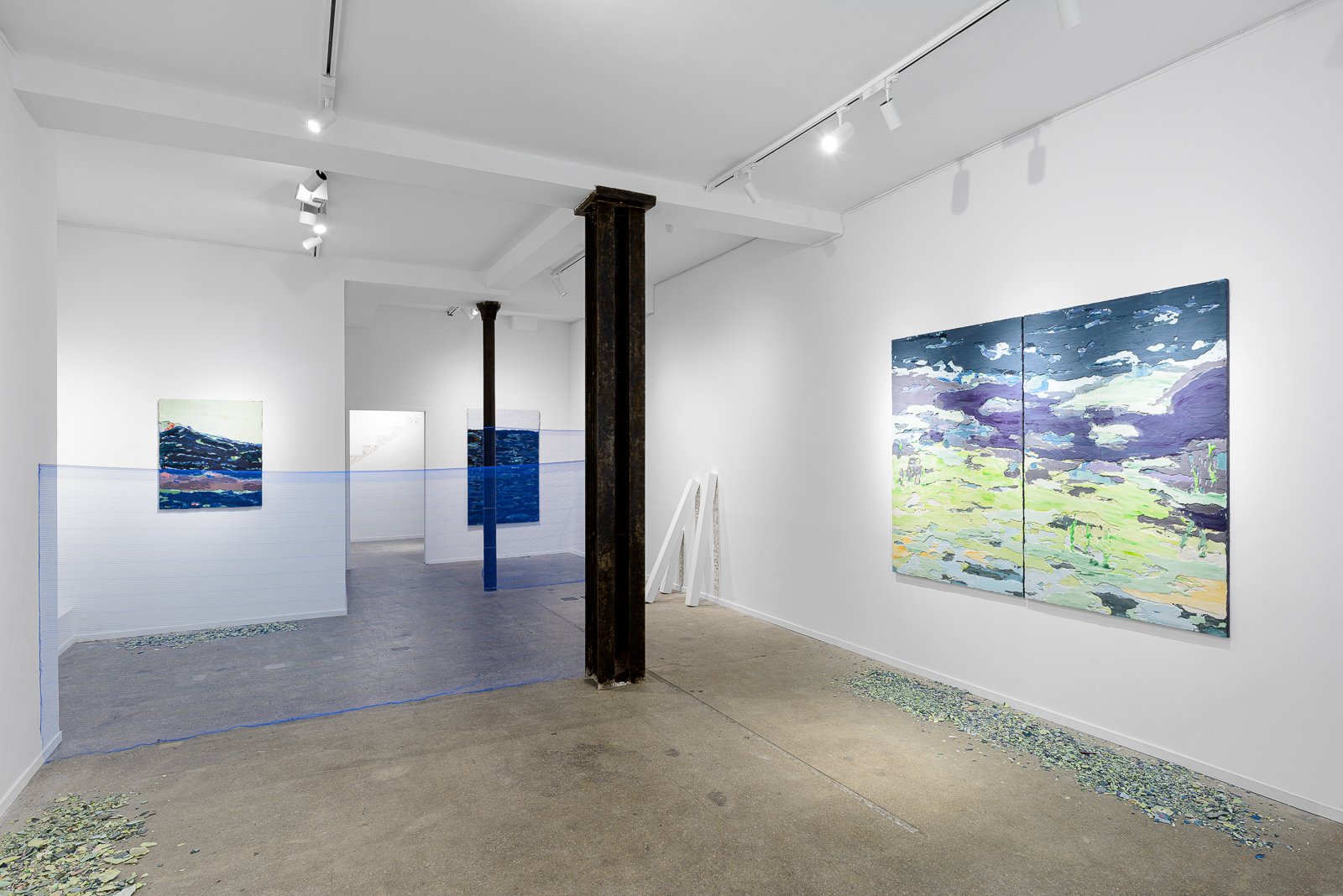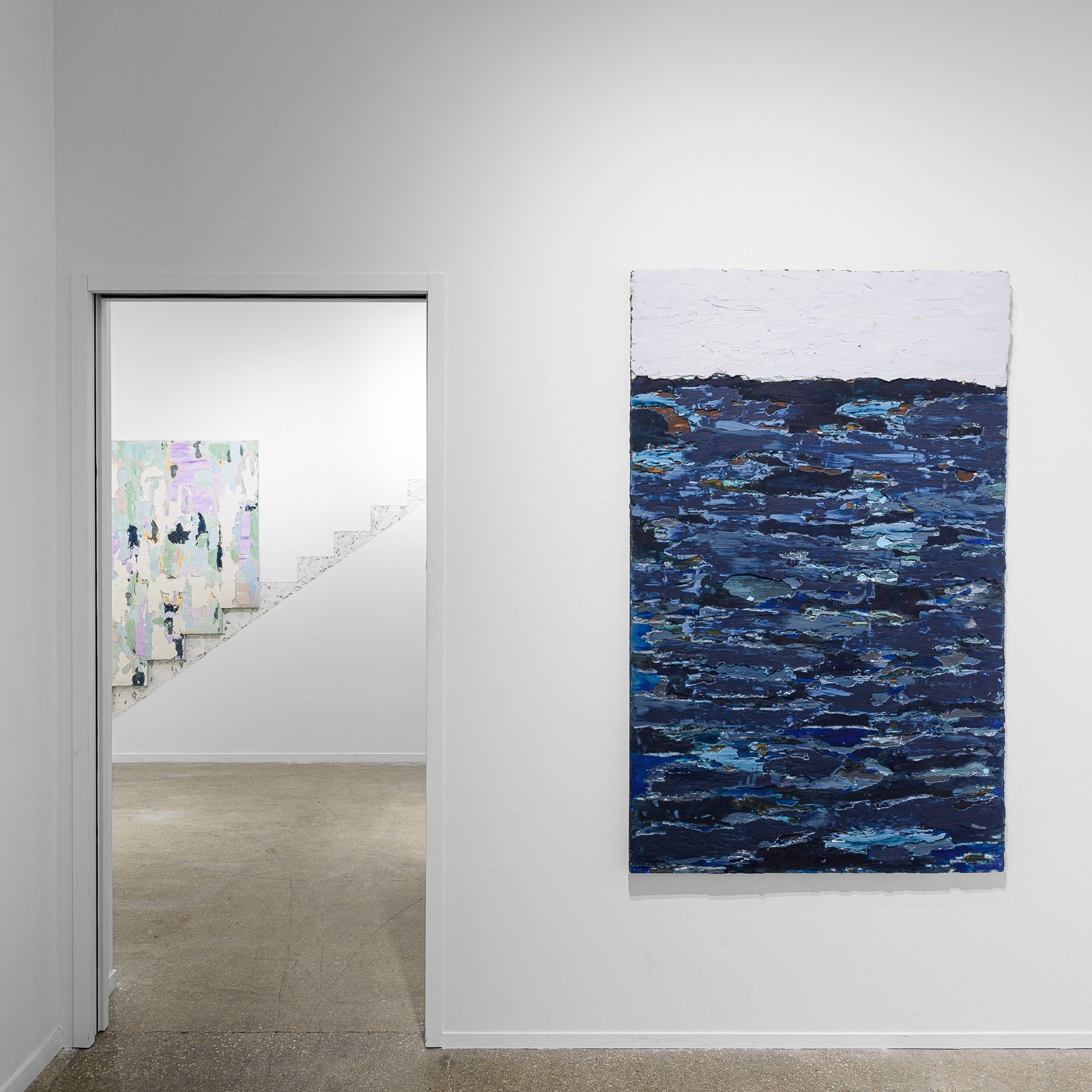HORIZONS ENFOUIS
Manoela Medeiros
Après son premier solo show à Marseille en 2018, la galerie est très heureuse de présenter «Horizons enfouis», la nouvelle exposition personnelle de Manoela Medeiros à Paris.
Du 3 septembre au 8 octobre 2022
Ouvert du mardi au samedi de 14h à 19h
_____________________
After her first solo show in Marseille in 2018, the gallery is very pleased to present "Horizons enfouis", Manoela Medeiros' new solo exhibition in Paris.
From 3 September to 8 October 2022
Open from Tuesday to Saturday, 2pm - 7pm
FR
Jusqu’à ce que l’horizon nous rejoigne
En 2014 Manoela Medeiros érige un mur en coin[1], espace rudimentaire adapté au corps qui vient s’y nicher – le sien – habitat minimal dans lequel il se tient, évolue, lentement s’y heurte, contraint, doucement détruit. Couche après couche le plâtre se détache de la structure et s’écrase sur le sol, forme d’érosion accélérée par les os, les muscles et la peau. D’archéologie inversée. Au contact de la chaire, le mur – membrane plus poreuse qu’elle ne veut bien l’admettre – devient le négatif d’une relation physique mouvementée. Ainsi marquée en creux, notre relation au monde se trouve comme inscrite dans la paroi, avec tous ses points de contact, violents ou apaisés, ses agitations et ses langueurs. De ce fait elle peut se lire, et survivre à l’instant passé.
En géologie, une couche stratigraphique marquée par divers phénomènes naturels tels qu’une éruption volcanique, un tsunami ou l’impact d’une météorite, mais également par l’accumulation de contenus fossiles, se nomme horizon. Ce même terme s’utilise en archéologie pour définir une large portion de territoire marquée par les mêmes restes, les mêmes artefacts : un morceau de temps figé dans le sol. Observer l’horizon nous permet donc de plonger dans l’histoire de la terre et de ses habitants, avec un peu de travail dans leurs vies, avec un peu de projection dans leurs rêves. Car si l’horizon cristallise le passé, il dessine aussi l’avenir.
En 2012 Manoela Medeiros explore à Lisbonne les entrailles d’un bâtiment délaissé, y dessine, y pose ses marques et en gratte la surface – à la main, le corps et la matière – qui peu à peu s’effrite et laisse apparaître du mur les multiples strates, couches de couleurs et de matières empilées. Avec ce carottage improvisé – elle parle d’excavation – c’est l’histoire du lieu qui se donne à voir, des personnes qui l’ont occupé, des histoires qu’il a accumulées, des vies qu’il a contenues, des rêves qu’il a laissé s’échapper.
En 1940, alors que le monde sombre dans la guerre, un jeune garçon fait la découverte d’une grotte aux parois peintes, non loin du château de Lascaux. L’histoire veut qu’un lapin apeuré ait entraîné dans ce lieu effacé la fougue d’un chien puis la curiosité de son maître. Après avoir retiré quelques pierres réapparaissent des formes plusieurs fois millénaires, des couleurs, des traces, rémanences de gestes et d’histoires depuis longtemps révolues. Et l’horizon se rapproche – par excavation devient présent, dans nos regards devient futur.
Manoela Medeiros explore donc à Lisbonne les entrailles d’un bâtiment délaissé. Pour elle l’expérience devient révélation, aussi bien qu’initiation : du site, elle extrait des fragments qui ensuite deviendront œuvres, de celui-là puis d’autres, au Portugal, en France et ailleurs, les mettant en proximité et par là rapprochant les histoires, les vies et les rêves oubliés. Depuis 2012 elle relie ces horizons divers[2], créant ainsi par collage de nouvelles réalités dans l’espace et le temps, histoires chimériques dessinées pour stimuler nos imaginaires.
En 1973 à Winchester, Edward C. Harris développe une matrice visant à analyser et schématiser les séquences stratigraphiques observées dans les fouilles archéologiques. Fonctionnels, ces dessins représentent le mille-feuilles d’horizons que le temps a produit dans un territoire – et les multiples strates résultant des vies qui s’y sont succédées – la manière dont ils sont agencés, leurs points de contacts, leurs porosités. Assez naturellement, Manoela Medeiros s’intéresse à cet outil scientifique qui, d’une certaine manière, condense l’agencement des histoires, des vies et des rêves, et entre en résonnance avec bon nombre de ses œuvres.
La dimension archéologique du travail de Manoela Medeiros s’exprime parfois sur site directement. Elle travaille alors en symbiose avec le lieu qui l’accueille, avec ses composantes naturelles[3], de ses murs révèle les strates cachées[4] – des couches de temps – les excave pour les donner à voir renouvelées[5]. En grattant ainsi les parois de l’espace d’exposition, elle crée des fenêtres sur ses vies passées, horizons mêlés dans lesquels nous sommes invités à nous plonger pour en recomposer les paysages – c’est la rencontre du territoire et de l’imaginaire.
Si le paysage est un territoire devenu image, un territoire augmenté, ou bien détourné, alors peut-être l’archéologie nous permet-elle par l’étude des sols de révéler les paysages passés, au moins partiellement. C’est ce processus, qui s’appuie sur le temps long, que Manoela Medeiros condense dans la série des Ruines, appliquant sur la toile de nombreuses couches de peintures et les excavant ensuite, grattant pour laisser apparaître sur le même plan l’accumulation de ces temporalités feintes. Procédurales[6], ces peintures ne cherchent pas à représenter les murs vieillis de nos villes, qui nous séparent du monde extérieur et sont voués à évoluer, à subir un processus de dégradation et sans doute à disparaître, laissant la nature les recouvrir et les réintégrer à son règne – forme de retour à la terre, et de réconciliation. Elles ne cherchent pas à en imiter la surface et les histoires, mais bien plus à en donner une image, en l’incarnant à en reproduire la force et les effets. Ainsi, ces toiles sont d’une certaine manière des œuvres mises en ruine, et des ruines mises en œuvre.
En 2015, Manoela Medeiros déplace une dune de sable vers une autre à l’aide d’un tamis[7], entreprise symbolique rendue vaine par l’usage de ce contenant qui, inévitablement, laisse les grains s’écouler le long du chemin. Répétée, l’action répartit le sable entre les deux dunes, à la manière d’un grand sablier qui voyant l’écoulement du temps vient fondre les horizons. Car si l’horizon cristallise le temps, les histoires et les vies, il contient également nos rêves et ceux des autres, qui étaient là avant nous et seront là après, les utopies qui nous ont gardés en vie. Alors il peut bien reculer, l’horizon, à mesure que nous avançons il peut bien s’éloigner, du moment que nous le gardons en vue – peut-être un jour nous rejoindra-t-il.
En 2022, l’horizon reste la perspective de Manoela Medeiros – les enfouis que nous excavons, les cachés que nous redécouvrirons, les lointains qui peut-être nous atteindrons – qui se déploie sous différentes formes dans l’espace d’exposition, qui nous est transmis bien sûr et vers lequel nous sommes invités à nous projeter. À la manière de son travail, ce texte s’est construit en strates imbriquées, à la recherche de lignes de forces et de perspectives, d’images et de paysages, d’évocations, d’intuitions ; en nuances car, comme le temps, son œuvre ne se construit pas comme un fleuve linéaire, mais se déploie en de nombreux méandres, qui s’écoulent et se croisent, s’éloignent et se rapprochent, jusqu’à ce que l’horizon les rejoigne.
Grégoire Prangé
Palerme – Lectoure, 2022
[1] Le propre univers plié en un coin, 2014
[2] Série des Continents
[3] Indice de paysage, 2015
[4] Paysage limite, 2015
[5] Voir par exemple Hiatus, 2015 ; Declíve, 2017 ; Frontière, 2017 ; Eclipse, 2018 ; Vão, 2021 ; etc.
[6] Jusqu’à parfois devenir instructions : Instruction pour la construction d’une ruine, 2015
[7] Déplacement de paysages, 2015
EN
Until the horizon reaches us
In 2014, Manoela Medeiros erected two walls to create a corner[1], a rudimentary space adapted to the body that would nestle within it – her own; it thus became a minimalist habitat where the body stood, evolved, slowly collided against the surface, became constrained, and then gently began to destroy. Layer by layer, the plaster detached from the structure and was crushed on the ground, a form of erosion that was accelerated by bones, muscles, and skin. A reverse archaeology. When in contact with flesh, the wall – a membrane more porous than it is willing to admit – becomes the negative impression of a turbulent physical relationship. Debossed in its surface, our relationship to the world is thus inscribed in the wall, with all its points of contact, whether violent or peaceful, its agitations, and its languor. As a result, it can be interpreted and survive beyond the past moment.
In geology, a distinctive stratigraphic rock layer that has been marked by natural phenomena such as volcanic eruptions, tsunamis, or meteorite impacts, or is distinguished by the accumulation of fossil contents, is called a horizon. This same term is used in archaeology to define a portion of a site that is characterised by the same types of remains, the same artefacts: a piece of time frozen in the ground. Observing the horizon allows us to dive into the history of the land and its inhabitants, provides insights into their lives and even facilitates a brief projection of their dreams. Because if the horizon crystallises the past, it also outlines the future.
In 2012, Manoela Medeiros explored the bowels of a derelict building in Lisbon; she made drawings on the walls, marked and scratched the surfaces – with her hand, with her body, with objects – and it gradually crumbled away, revealing multiple strata, accumulated layers of colours and materials. Through this improvised coring – she evokes the notion of excavation – the history of the place is revealed: the history of the people who have occupied it, the stories it has collected, the lives it has contained, the dreams it has let escape.
In 1940, as the world was descending into war, a young boy discovered a cave with painted walls, not far from the Château de Puy Robert Lascaux. As the story goes, a frightened rabbit incited a dog to investigate this forgotten place and the curious master followed. After moving a few stones, forms emerged, forms that dated back thousands of years, colours, traces of gestures, and stories that had long since elapsed reappeared. And the horizon comes closer – excavation becomes the present, our gaze becomes the future.
So, in Lisbon, Manoela Medeiros explored the bowels of a neglected building. For her, the experience was both a revelation and an initiation; she extracted fragments from that first site that would later become works of art, and this process was repeated at sites in Portugal, France and elsewhere, establishing a proximity between them and thereby bringing together their stories, lives, and forgotten dreams. Since 2012, she has been linking these diverse horizons[2], creating new realities in space and time through collage, creating chimeric stories to stimulate our imaginations.
In 1973 in Winchester, Edward C. Harris developed a matrix to diagram the sequences of time observed in the stratigraphic layers of archaeological excavations. Functional by nature, these diagrams represent the myriad of horizons that time has produced in a territory – and the multiple strata that have resulted from the lives that have succeeded one after another – and therefore reveal their structures, their points of contact, their porosities. Quite naturally, Manoela Medeiros took an interest in this scientific tool, which, in its own way, condenses the structure of stories, lives, and dreams, and thus resonates with much of her artwork.
The archaeological dimension of Manoela Medeiros’ work is sometimes expressed once she is at a site. She works in symbiosis with the space that surrounds her, with its natural components[3], with its walls and their hidden strata[4] – layers of time – and excavates them so to present them in a new light.[5] By scraping at the walls of an exhibition space, she creates windows onto their past lives, mixed horizons that we are invited to delve into as a way to recompose the landscapes – it is the meeting of a territory and the imaginary.
If a landscape is a territory that has become an image – an augmented or co-opted territory – perhaps archaeology, by surveying the soil, can allow past landscapes to be at least partially revealed. This process, which depends on such long periods of time, is condensed by Manoela Medeiros in the Ruins series as she applies numerous layers of paint to the canvas and then excavates them, scratching away at them to disclose the accumulation of these feigned temporalities that exist on the same plane. These paintings are procedural[6], they do not seek to represent the aged walls within our cities that separate us from the outside world and that are destined to evolve, to undergo a process of degradation, and, no doubt, to eventually disappear, leaving nature to cover them and reintegrate them into its realm – a type of return to the earth, of reconciliation. Nor do the works seek to imitate the surfaces and stories of walls, but rather to give an image of them, to embody them and reproduce their strengths and effects. Therefore, in a certain manner, these paintings are works brought into ruin and ruin brought into works.
In 2015, Manoela Medeiros moved one sand dune to another with the help of a sieve[7], a symbolic enterprise rendered futile due to the use of a device that inevitably allowed the grains of sand to trickle through and scatter along her path. The repeated action gradually distributed the sand between the two dunes, somewhat like a great hourglass that, having witnessed the passage of time, thus dissolved the horizons. For if the horizon crystallises time, stories, and lives, it also contains our dreams and those of others, those who were there before us and will be there after, the utopias that have kept us alive. So, the horizon may well recede, as we move forward it may well move farther away, but as long as we keep it in sight, perhaps one day it will join us.
In 2022, the horizon remains Manoela Medeiros’ perspective – the buried that we excavate, the hidden that we rediscover, the distant that may well one day reach us – and it unfolds in different forms in the exhibition space, forms that are, of course, transmitted to us and that we are invited to project ourselves into. In the manner of the artist’s work, this text has been constructed in overlapping layers, in search of lines of force and perspectives, images and landscapes, evocations, intuitions; in nuances because, like time itself, her work is not constructed as a straight river, but one that lays itself out in numerous meanders, that flows and intersects, moves away and comes closer, until it meets the horizon.
Grégoire Prangé
Palermo – Lectoure, 2022
[1] Le propre univers plié en un coin, 2014
[2] Continents series
[3] Indice de paysage, 2015
[4] Paysage limite, 2015
[5] See, for example, Hiatus (2015), Declíve (2017), Frontière (2017); Eclipse (2018), Vão (2021), etc.
[6] At times to the point they become instructions: Instruction pour la construction d’une ruine, 2015
[7] Déplacement de paysages, 2015
Ruine paysage, après la pluie
Paint, pigment coating & excavation on canvas
2 x 160 x 100 cm
Ruine paysage lointain
Paint, pigment coating & excavation on canvas
145 x 200 cm
Ruine escalier
Paint, pigment coating & excavation on canvas
200 x 160 cm
Ruine paysage, horizon
Paint, pigment coating & excavation on canvas
160 x 100 cm
Ruine paysage, montagne
Paint, pigment coating & excavation on canvas
92 x 73 cm
Ruine paysage, rivière
Paint, pigment coating & excavation on canvas
92 x 73 cm
Ruine (verte, grise et bleue)
Paint, pigment coating & excavation on canvas
92 x 73 cm
Ruine paysage, forêt sauvage
Paint, pigment coating & excavation on canvas
100 x 81 cm

